Sometimes I wonder why they bother. In an article which reviews Ruger’s new mini-wonder pistol, the field-stripping process is described thus:
Field stripping is easily accomplished by following the directions in the instruction manual. That’s the usual gunwriter verbiage, but it isn’t quite what I experienced with the 57. Following the direction to ensure the pistol is unloaded, the slide is first locked to the rear.
Opposite the takedown lever is a pin that takes a bit of effort to depress. Ruger recommends using the base pad of one of the magazines; I ended up using a punch. Once the takedown lever is protruding from the frame, it can be rotated down. Next, rather than the conventional method of running the slide forward off the frame (I warned you to read the directions) the slide is moved forward about a quarter inch, then lifted straight up.
The recoil spring and barrel can then be removed from the slide in the usual manner. Ruger has designed this pistol to be taken apart without the need to press the trigger, a feature I heartily applaud.
Reassembly is quite easy if one follows the instructions, but entirely impossible if, somehow while messing around with it, the takedown lever is allowed to snap back into the frame. (Ask me how I know.) Anyway, it really is quite easy, but I enjoin you, make sure the takedown lever is still out (or in the disassembly position) should you wish to avoid a couple of frustrating hours mucking about.
OR:
Ruger could just have made their new wunder-pistole come apart like their own Mk IV .22 pistol, namely:
- Remove all boolets (and the mag) from the gun.
- Cock the piece and click the safety catch up into SAFE.
- Press the little button under the slide tabs at the back.
- Lift the slide assembly off the frame.
And that’s it: no special tools, no screwdrivers, no coins, nothing. The firing pin assembly is loose in the slide, and just drops out into your hand for cleaning. Here’s a pic-by-pic:
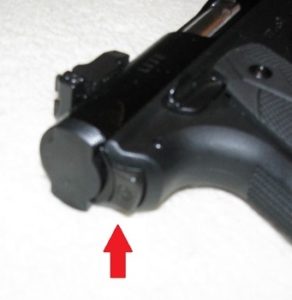
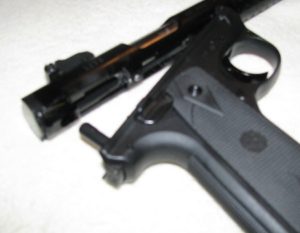
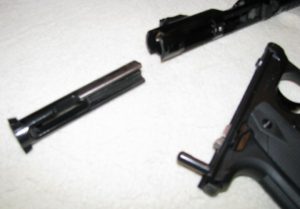
And now for the best part: the reassembly.
- Slip the firing pin assembly back into the slide (it can only go one way).
- Place the slide’s hinge hook back into the front of the frame.
- Drop the slide back onto the frame, and push it closed until you hear the click.
- You’re ready to start shooting.
Best part: I never had to consult the manual.
Did Ruger do that? No. Instead, they made the new 57’s field-stripping procedure more akin to the older Mk I/II/III pistols: a study in frustration.
I don’t know the answer to this (but I’m willing to learn): how difficult would it have been just to stretch out the Mk. IV’s frame and breech to accommodate the longer 5.7x28mm cartridge? Or, for that matter, the .22 Win Mag?
Oh, wait, I forgot: that wouldn’t engender the same increase in sales (and all the concomitant gun-magazine hype) that a new pistol would.
Instead, Ruger seems to have made a “new” pistol which hearkens back to the past.
Not interested.
Now if I were seriously interested in the 5.7x28mm ratshooter cartridge (a BIG if), I’d be far more likely to look at the PS90 mini-carbine:
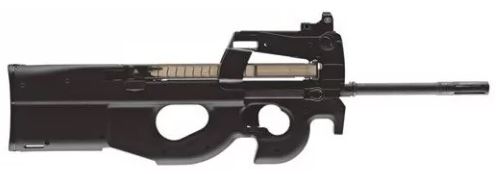
I shot Doc Russia’s daughter’s PS90 a couple weeks back, and it was a sweetheart (albeit as ugly as Rosie O’Donnell). But that gun’s way too spendy (over a grand and a half), so: no.
I just can’t get excited about a new cartridge which is simply a very hot .22 Win Mag and which would cost an arm and a leg to get into, what with all the new guns etc.
I have enough calibers in Ye Olde Gunne Sayfe, so: no.
What I may look at, if ever the funds become available, is the Kel-Tec PMR-30 in .22 Win Mag (of which I may already have one or two rounds in Ye Olde Ammoe Locquer)…
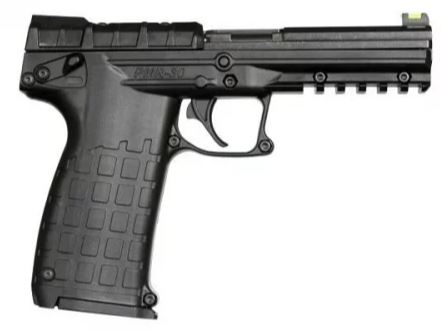
…and it’s all Ruger’s fault.
Or am I missing something, and is the 5.7x28mm the absolute bee’s knees? Chuck Hawks doesn’t seem to think so.

I have no experience with the other firearms in this post, but the new Ruger .22s are a joy. Accurate, reliable, and as you mention, easy and intuitive to field strip for cleaning.
I got one of the Mark IV 22-45s. The grip is designed to mimic a 1911, so it can serve as a practice pistol. I prefer that grip angle to the standard Ruger design. The top end is the Mark IV with the takedown button.
It deserves a post of its own.
It did.
https://www.kimdutoit.com/2017/02/27/nice-surprise/
You must have been asleep that day.
By coincidence I have Ruger pistols on my mind.
I’m off this morning to spend an unexpected tax refund windfall on a new 9mm pistol. I had settled on a Ruger American Pro because it’s fairly light, cheap, specced for +P, with some good features including ambidextrous – I shoot with my brother who is left handed. Alternatively, the Remington RP9, also ambidextrous, a bit lighter and holds 18 rounds.
I’ll try to fire before I buy, but it’s a small market where I live and often the dealers will not let you try before you buy.
Have any of our host, commenters or lurkers any experience with these guns? +P 9mm ammo?
Wife has advised me that if I come home with both of them there will be hell to pay.
Haven’t shot either, so I’m no help, I’m afraid.
No CZ 75s available up there?
https://www.kimdutoit.com/2018/11/16/gratuitous-gun-pic-cz-75b-9mm-and-40-sw/
I have heard bad, bad (very bad) things about the RP9.
Some work OK, but they are simply not reliable enough for defensive purposes. I was interested in this one for a while, but there’s no way to save enough money to justify gambling on a pistol that could be junk. Not when there are lots of other very good offerings. (Kim’s suggestion of a CZ for a start.)
I seem to recall the directions of one of the earlier Ruger .22s requiring three hands to disassemble, something like “Hold this with your right hand, do this with the left, then do something with the other hand.”
Yeah, that’d be the Mark 1 – 3. A study in frustration. I have a Mark 3 .22/45 (i.e. the one with the M-1911-angle grip as opposed to the Luger style) and it seems like I have to re-learn the process each time. There is at least one specific doo-hicky that has to hang at exactly the right angle in order to get the thing back together. I now kind of wish I’d held out for a Mark 4 but reassembly aside, the Mark 3 with its heavy barrel is a joy to shoot.
Prehensile fingers?
Umm, you need all your fingers (and then some) plus a prehensile penis.
The disassembly/reassembly process of the Ruger MKII is why I own a Browning Buckmark.
I was fortunate and inherited a Smith and Wesson Model 41 7″ bull barrel. What a dream! I want to rework the grips, though, and need to start from scratch since I refuse to damage the originals. Otherwise, a wonderful pistol.
I own one of the KelTec PMR 30’s. Spare mag’s are pricey, but not terribly so. The gun shoots about as well as any other semi-auto I own, but the design of the handle is a bit more narrow than I find comfortable to shoot for very long (second mag starts getting painful on the web of the palm). Mostly the gun resides in the closet due to a lack of ammo availability. Kel Tec recommends firing ammo with 50 grain bullets at a minimum. Until I can reliably go down to Academy or the local gun shops and find at least a few boxes of CCI (or equivalent) .22 Win Mag in that bullet weight, I’m going to continue reserving that gun for extreme circumstance. That notwithstanding, from my experience with the gun, this is certainly one that ought to be on any shooters “to buy” list.
Will,
IIRC nobody makes the .22 WMR in any weight more than 45gr (and only Winchester DynaPoint at that), except for subsonic and shotshells, so either you done a typo or Kel-Tec is FOS.
I don’t have one but snipped from the online manual:
The PMR-30 pistol functions best with high power ammo, often with bullet weights of 40gr and up. This includes, but is not limited to, the following:
-CCI Maxi Mag 40gr
-Winchester Super-X 40gr
-Remington Premier Magnum 33gr
My apologies for referencing Fort Hood, but the 5.7 is a very effective stopping round. Every person there shot centre of mass died. None of the wounded were able to continue the fight, and when the shooter was shot, it took 4 rounds of 9mm to do the job – even then, he lived.
The link below is to a FN forum, and has more detail. The bottom line is, this is a whole lot more effective than a 22 mag, and being CF, will be a lot more reliable.
https://fnforum.net/forums/fn-five-seven/56428-lethality-fn-5-7-platform.html
I maintain that the P90 isn’t anywhere NEAR as ugly as Rosie O’Donnell. Granted, it doesn’t look much like a run-of-the-mill firearm, but there’s a sculptural quality to it. If I was going to own firearms (natural clumsiness suggests it would be a bad idea), the P90 is one of the ones I’d be interested in.
Now the HK G-11, quite aside from its overcomplicated mechanism and not-quite-ready-for-prime-time ammunition, is ugly as a mud fence. WELL into Rosie territory.
Bought my MK I new in 1978–standard 4-inch barrel. Later I managed to snag an AMT 6 inch SS heavy barrel assy. I also installed a Volquartsen trigger and grips. It still performs flawlessly and is death-ray accurate.
A few year back, I began to notice bit of sharp metal on metal contact during recoil. Time to replace the recoil spring. This is what I used–
https://volquartsen.com/inventory_configurations/1086
You have to read the specs to see that they do list the MK I. Works perfectly, drops right in. I installed it as it came with the standard spring, and am running Aguila “22 Super Extra / Long Rifle High Velocity Copper-Plated Solid Point NO. 1B222328”.
As to some of Ruger’s later designs, Bill always was one to “lawyer-up” his guns. My Single-six is a three-screw. And yes, I have both cylinders, 22LR and 22 mag.